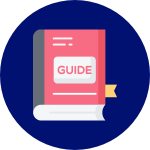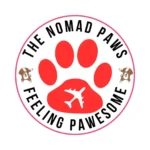Want to take your furry friend out for dinner? We have you covered! This article is all about dining out with your dog, and we’re here to make it a breeze.
Let’s face it, more restaurants are welcoming pets these days. It’s only natural that we want to include our four-legged pals in our social outings, right?
But here’s the thing: not all dogs are ready for the restaurant scene.
Don’t worry, though! We’re going to walk you through everything you need to know. From basic commands to fancy social skills, we have the tips and tricks that’ll have your pup behaving like a pro at (or under) the dinner table.
What makes our advice special? Well, it comes straight from a certified dog trainer with over a decade of experience.
This isn’t just theory, folks. We’re talking real-world, tried-and-tested tips that actually work.
So, are you ready to turn your dog into the perfect dining companion? By the time you finish reading, you’ll be all set for stress-free, tail-wagging restaurant adventures. Trust us, your taste buds (and your dog) will thank you!
The Important Stuff
- Practice fundamental obedience commands like ‘come’, ‘leave it’, and ‘heel’ before dining out.
- Teach your dog “watch me” and “place” cues to maintain focus and prevent unwanted behavior.
- Socialize your dog at outdoor spaces to develop essential interactive skills.
- Ensure your dog is comfortable around food and people by performing ‘leave it’ exercises.
- Packing essentials like treats, toys, and cleanup bags helps ensure a stress-free dining experience.
Essential Training Before Dining Out
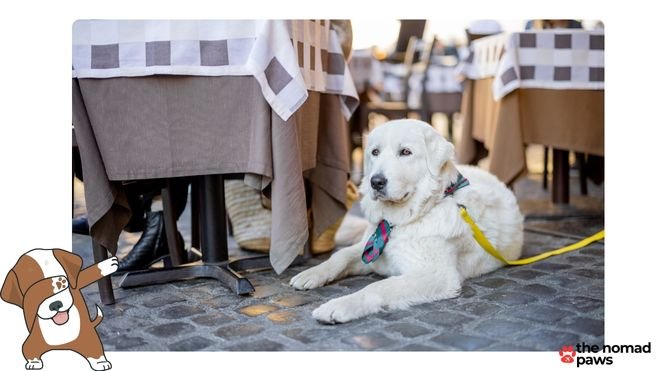
So, you’re thinking about taking your furry friend to a pet-friendly restaurant? That’s awesome! But before you go, let’s talk about some important training tips.
First things first, you’ll want to teach your pup some basic commands. Sit, stay, come, and leave it are like the ABCs of dog obedience. These tricks will help you keep your dog in check when you’re out and about.
Ever heard of clicker training? It’s pretty cool!
You use a clicky sound to tell your dog they’ve done something right, and then give them a treat. This method can really help your dog focus, even when there’s a lot going on around them.
But why stop at the basics? Teaching your dog some fancy moves like heel and wait can be super helpful too.
These advanced tricks give you more control when your dog isn’t on a leash. And don’t forget about distraction training! It’s vital for helping your pup ignore all those tempting smells and friendly faces at the restaurant.
Behavior Around Food and People
To help your dog behave well during meal times, you can teach them a few important commands. Start by teaching them ‘leave it’ and ‘stay’ while you’re eating. This will prevent begging and food aggression issues. Make sure your dog is comfortable with people approaching them while they eat.
Next, work on teaching your dog to sit calmly under the table or in a specific area. This will help them learn good table manners. It’s also important to socialize your dog so they can interact calmly with strangers.
Impulse control is key – your dog needs to resist the temptation to grab food from the table. As you work on these behaviors, it can also be helpful to understand how Adaptil Transport Spray helps dogs stay calm. With patience and practice, your dog will learn to behave well, making dining out with them a joy.
Practice in pet-friendly areas
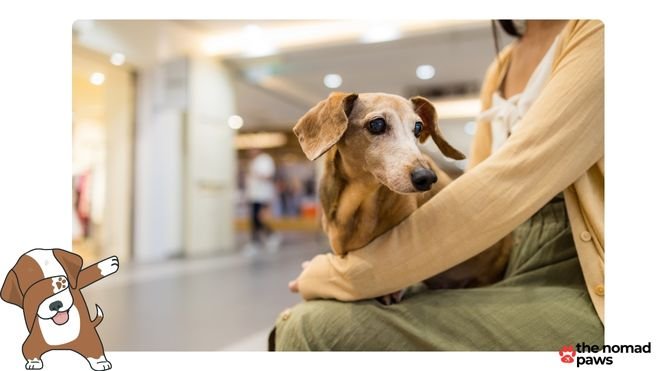
Practice socializing and training your dog in pet-friendly areas like dog parks, cafes, and shopping centers before taking them to a restaurant to help them get accustomed to the many distractions and stimuli they’ll face.
Outdoor training in these areas will help your dog develop essential socialization skills, such as interacting with people and other dogs, and distraction management, like ignoring loud noises and food temptations.
Use positive reinforcement techniques, like treats and praise, to encourage good behavior.
Set clear boundaries and consistently reinforce them to guarantee your dog understands what’s expected of them.
For example, if your dog starts to get too excited or aggressive, calmly and firmly correct them and reward calm behavior.
Choosing the Right Venue
You’ll want to scout out dog-friendly restaurants that meet specific standards to make sure the experience is pleasant to both you and your dog.
When searching for the perfect spot, look for dog-friendly restaurants that are known to welcome dogs. Some establishments even offer a menu for dogs, complete with pup-friendly treats and meals.
Outdoor patios are also a must, since they offer a cozy outdoor space for your dog to relax while you enjoy your meal. A pawsome ambiance is essential, creating a relaxed atmosphere where you and your dog can feel at ease.
Consider the noise level, seating arrangements, and overall vibe to make sure it’s suitable for your furry friend.
Some restaurants even offer dog beds, toys, and other amenities to make your dog feel right at home. Here on The Nomad Paws we have an entire section dedicated to the best spots where you can enjoy a meal or a drink with your furry friends.
Here are a few examples:
- Where to Eat with Your Dog in Bend, Oregon
- Where to Eat with Your Dog in Salt Lake City
- Where to Eat With Your Dog in Charleston, SC
- Where to Eat with Your Dog in Sedona: Our Picks
Preparing for the Restaurant Visit
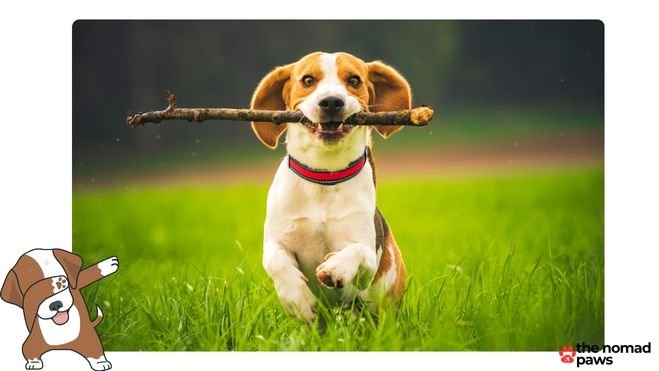
Before heading out to the restaurant, take your dog outside for a quick potty break to make sure they’re empty and ready for an enjoyable, accident-free dining experience. This is especially important if you’ve had a busy morning or skipped a walk schedule.
A pre-dinner bathroom break ensures your dog is relieved and focused on the outing, not on finding a spot to do their business.
Incorporate potty training into your daily routine to avoid accidents. Regular outdoor playtime and walk schedules help your dog develop good habits.
Take a few minutes to let your dog sniff, circle, and do their business. With a clear bladder and a happy belly, your dog will be ready to enjoy the outing with you.
Exercise your dog to reduce restlessness
One hour prior to your restaurant visit, fit in a 15- to 30-minute exercise session with your dog to burn off excess energy and reduce restlessness. This will help your dog feel more relaxed and focused.
Choose outdoor activities that provide mental stimulation, such as a brisk walk, jog, or playtime in the park.
Ensure your dog is well-groomed
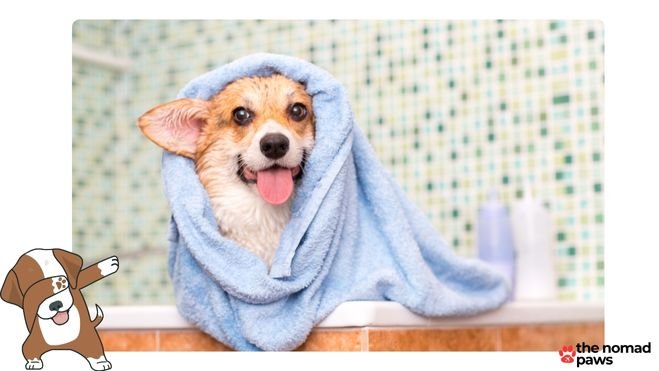
Give your dog a thorough grooming session, including a bath, nail trim, and brushing, to make sure they look and smell their best for the restaurant visit.
A well-groomed dog isn’t only aesthetically pleasing but also shows respect for the establishment and its patrons. Start with brushing techniques that handle knots and mats, using a gentle touch and the right brush for your dog’s coat type.
Don’t forget nail trimming to prevent scratching and ear cleaning to reduce odor. Teeth brushing is also very important to prevent bad breath and promote overall health.
Packing Essentials for Dining Out
Your dog’s good behavior in a restaurant depends on consistent positive reinforcement, so pack treats that are both tasty and convenient to dispense.
This way, you can immediately reward your dog for calm, polite behavior, such as sitting quietly or ignoring food scraps on the floor.
Positive reinforcement training techniques rely on associating good behavior with pleasing consequences, and treats are a powerful tool in this process.
When selecting treats for dining out, opt for small, bite-sized morsels that are easy to eat and won’t make a mess. You can also use treat training to teach your dog new skills, like ‘settle’ or ‘leave it.’
Be sure to track your training progress, noting what works and what doesn’t, so you can adjust your approach as needed.
Bring toys to occupy your dog
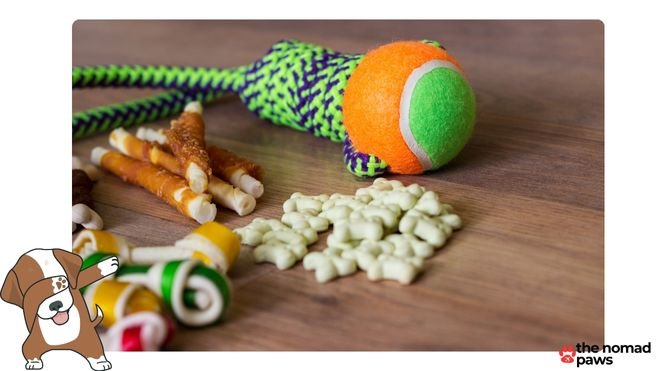
Pack a few of your dog’s favorite toys to keep them occupied and engaged while you’re dining out. This is particularly important if your dog gets anxious or restless in new environments.
Interactive toys, such as the Nina Ottosson puzzle toys or squeaky balls, provide mental stimulation and can keep your dog busy for extended periods.
Chew distractions, like Cadet Bully Sticks or the Pet Factory rawhide chews, can also be a lifesaver when you need a few minutes to enjoy your meal.
By bringing toys and engaging in play, you’ll not only keep your dog happy but also reduce the likelihood of unwanted behaviors like barking or whining.
Have cleanup bags ready
Don’t forget to add cleanup bags to your packing list. These are a necessary item for any pet parent who wants to be ready for accidents.
These bags are vital for responsible ownership and environment maintenance. You never know when your furry friend might’ve an unexpected accident, and having cleanup bags on hand guarantees you can clean up quickly and discreetly.
Make sure to dispose of the bags properly, following local waste management guidelines. It’s also a good idea to have a few extra bags stashed away in your car or purse, just in case.
At the Restaurant: Etiquette and Tips
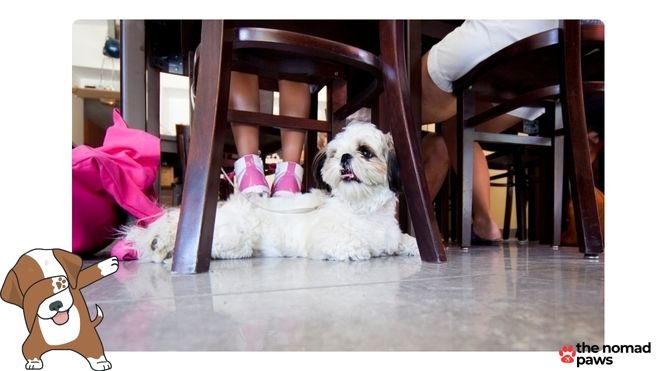
Keeping your dog leashed is a must when you bring your pup to a restaurant, as it ensures their safety and prevents them from disrupting other diners.
When dining outdoors with your canine companion, you need to make sure that your dog is leash-trained properly. This means your dog should walk beside you, not pull ahead or lag behind.
To achieve this, practice leash training at home, rewarding your dog for staying by your side.
At the restaurant, choose a table with enough space for your dog to comfortably sit or lie down without obstructing the aisle.
Remember to keep your leash at a comfortable length, allowing your dog to move freely without getting tangled or distracting other patrons.
Managing Food and Treats
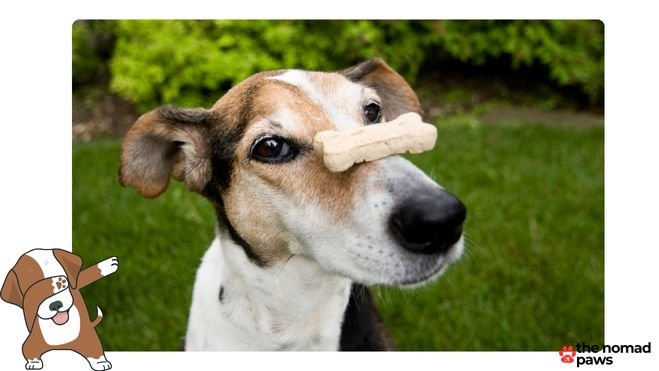
Controlling their access to food and treats is essential to avoid unwanted begging and stealing, which can lead to all sorts of unpleasant issues.
Food aggression can quickly become a problem if your dog is allowed to snatch food from the table or counter. To prevent this, establish a treat training routine that rewards good behavior, such as sitting or staying calm, with healthy treats.
Implement a reward system that reinforces table manners, like ignoring food and not begging.
Set clear food boundaries by designating specific areas where your dog can and can’t eat.
At the restaurant, keep your dog on a leash and away from the table to avoid temptation. If your dog does try to beg, calmly say ‘no’ and redirect their attention to an acceptable treat.
Water for Hydration
You’ll want to make sure your dog stays hydrated by bringing a portable water bowl and a refillable water bottle to the restaurant. This hydration tip is essential, especially on hot days or during prolonged meals.
Invest in a lightweight travel bowl that’s easy to clean and store. Pair it with the MalsiPree portable water bottle that can be easily refilled at the restaurant. Take regular water breaks to make certain your dog is drinking enough water.
Make it a habit to offer your dog water frequently, especially if they’re not used to eating outside.
Monitoring and Correcting Behavior
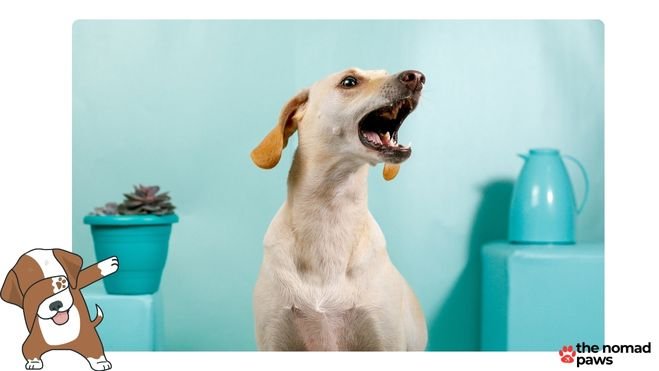
At the restaurant, pay attention to your dog’s body language and behavior, as it’s your cue to step in if they start becoming anxious, excited, or misbehaved. Catching these cues early allows you to redirect their behavior before it escalates.
Use positive reinforcement by rewarding good behavior, such as calm sitting or lying down, with treats and praise.
Consistent corrections are crucial, so if your dog starts to get rowdy, calmly and firmly say ‘settle’ or ‘relax’ to redirect their attention.
Avoid scolding or punishment, as this can create anxiety and exacerbate the situation. Instead, focus on rewarding good behavior, and your dog will learn to associate calm, controlled reactions with positive outcomes.
Handling Distractions and Interactions
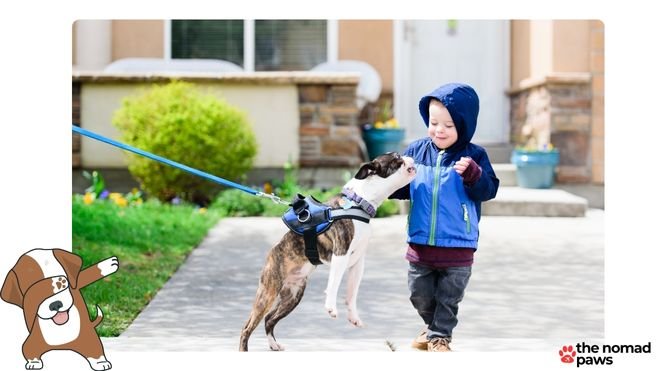
Since you are not going to be alone at the restaurant, you need to prepare your dog for interactions with other diners and dogs, which can be a significant distraction from their training.
Socializing strategies are key to ensuring your dog is calm and composed in these situations.
Teach your dog to respond to cues like ‘leave it’ and ‘watch me’ to help them focus on you instead of other dogs or people.
Canine communication is also essential – like I said earlier, pay attention to body language and behavior to recognize signs of anxiety or excitement.
Establish a playtime protocol to prevent over-excitement, and practice manners at mealtime by teaching your dog to wait calmly for food. Setting interaction boundaries is also crucial, as you don’t want your dog to become too clingy or demanding.
Dealing with Unexpected Situations
You’ll inevitably encounter unexpected situations while dining out with your dog, so it’s on you to prepare them for distractions and interactions that can throw them off track.
To handle loud noises, like clanging dishes or sudden music, desensitize your dog by exposing them to similar sounds at home. Reward calm behavior and gradually increase the volume.
Dealing with crowded spaces can be overwhelming, so practice walking your dog through busy areas, like shopping malls or parks, to build their confidence.
Addressing sudden movements, like a waiter rushing by, requires teaching your dog to focus on you amid distractions.
Managing unfamiliar scents, such as strong cooking smells, involves introducing your dog to various aromas in a controlled environment.
Reacting to unexpected behaviors, like a child suddenly approaching, demands socialization and training your dog to remain calm in the face of surprises.
What to do if your dog has an accident

Accidents can happen, and having a plan in place will help you minimize the disruption and ensure your dog’s comfort if they’ve an accident while dining out.
When it comes to accident prevention, clean up is key.
Be prepared with poop bags, wipes, and a spare leash in case you need to quickly exit the area. If an accident does occur, stay calm and composed to avoid stressing your dog further.
Use this opportunity to reinforce training with positive feedback, rewarding your dog for remaining calm or responding to commands.
Don’t let embarrassment hold you back – instead, focus on moving forward and learning from the experience. Consistency and patience play a significant role in these situations, so remember to breathe and stay patient.
Turn this mishap into a learning opportunity, and use it to encourage progress in your dog’s training. By staying calm and in control, you’ll help your dog feel more at ease, and you’ll be better equipped to handle similar situations in the future.
Post-Visit Etiquette
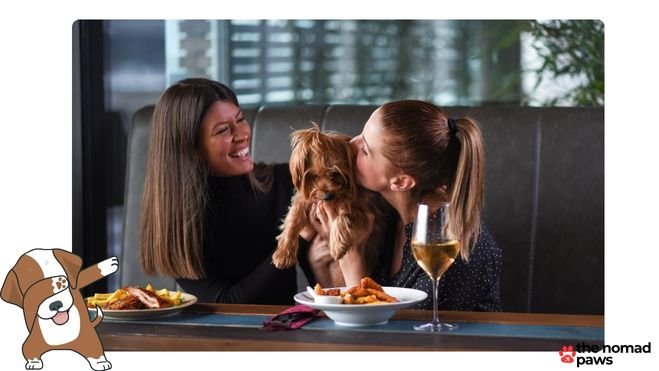
How often do you find yourself apologizing to the restaurant staff or other patrons for your dog’s messy mistakes, wondering if you’ve done enough to restore the area to its original state?
Cleaning up after your dog is important when dining out, and you need to do it efficiently.
Start by picking up after your dog immediately, using poop bags or a scoop to collect their waste. Proper disposal is equally important, so make sure to throw the waste away in a trash can.
A quick cleanup is also necessary, so bring wipes or a damp cloth to wipe down any surfaces your dog may have come into contact with. To avoid messes, keep an eye on your dog at all times and be prepared for accidents.
Keeping it tidy is a must, so take a few extra minutes to guarantee the area is spotless before leaving.
Reviewing and Adjusting for Future Visits
After making sure the area is spotless, take a moment to reflect on your dog’s behavior and your own preparedness during the outing, identifying what went well and what needs improvement for future visits.
This feedback reflection is essential in making future adjustments and improving your pup’s behavior.
Think about your dog’s mealtime manners – did they remain calm and quiet, or did they get excited and barky? Were there any behavior modifications you could’ve made to prevent incidents?
Consider what training tweaks you can make to enhance your dog’s behavior.
Perhaps you need to work on ‘quiet’ or ‘settle’ commands, or practice walking them on a loose leash. Make a mental note of what you’ll do differently next time, and prioritize those areas for future training sessions.




